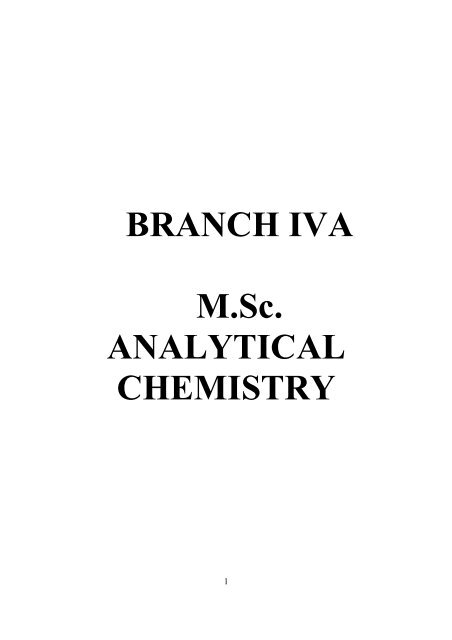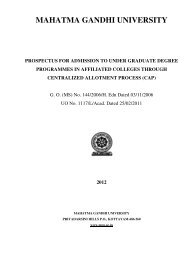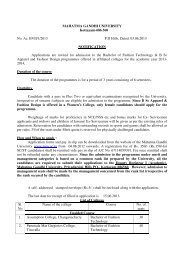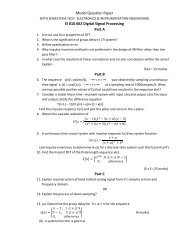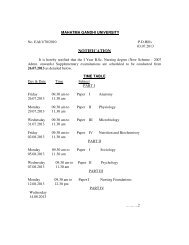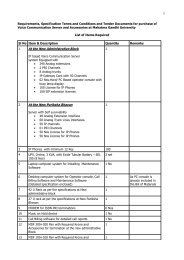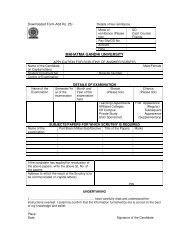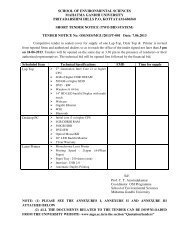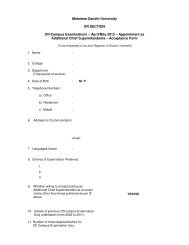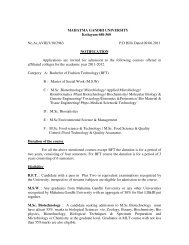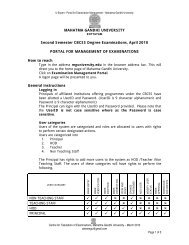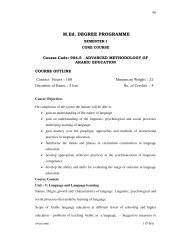M.Sc ANALYTICAL CHEMISTRY - Mahatma Gandhi University
M.Sc ANALYTICAL CHEMISTRY - Mahatma Gandhi University
M.Sc ANALYTICAL CHEMISTRY - Mahatma Gandhi University
Create successful ePaper yourself
Turn your PDF publications into a flip-book with our unique Google optimized e-Paper software.
Unit 4: Organometallic Polymers(9 Hrs)4.1 Polymers with organometallic moieties as pendant groups, polymers withorganometallic moieties in the main chain, condensation polymers based onferrocene and on rigid rod polyynes, polymers prepared by ring openingpolymerization, organometallic dendrimers.Unit 5: Bioinorganic Compounds(18 Hrs)5.1 Essential and trace elements in biological systems, structure and functions ofbiological membranes, mechanism of ion transport across membranes, sodiumpump, ionophores, valinomycin and crown ether complexes of Na + and K + , ATPand ADP. Photosynthesis-chlorophyll a, PS I and PS II. Role of calcium in musclecontraction, blood clotting mechanism and biological calcification.5.2 Oxygen carriers and oxygen transport proteins-haemoglobins, myoglobins andhaemocyanin, haemerythrins and haemevanadins, cooperativity in haemoglobin.Iron storage and transport in biological systems-ferritin and transferrin. Redoxmetalloenzymes-cytochromes, peroxidases and superoxide dismutase andcatalases. Nonredox metalloenzymes-CarboxypeptidaseA-structure and functions.Nitrogen Fixation-nitrogenase, vitamin B 12 and the vitamin B 12 coenzymes.5.3 Metals in medicine-therapeutic applications of cis-platin, radio-isotopes and MRIagents. Toxic effects of metals(Cd, Hg, Cr and Pb).Unit 6: Nuclear Chemistry(9 Hrs)6.1 Fission products and fission yield. Neutron capture cross section and critical size.Nuclear fusion reactions and their applications. Chemical effects of nucleartransformations. Positron annihilation and autoradiography. Principles ofcounting technique such as G.M. counter, proportional, ionization andscintillation counters. Cloud chamber.6.2 Synthesis of transuranic elements such as Neptunium, Plutonium, Curium,Berkelium, Einsteinium, Mendelevium, Nobelium, Lawrencium and elementswith atomic numbers 104 to 109.6.3 Analytical applications of radioisotopes-radiometric titrations, kinetics ofexchange reactions, measurement of physical constants including diffusionconstants, Radioanalysis, Neutron Activation Analysis, Prompt Gama NeutronActivation Analysis and Neutron Absorptiometry.6.4 Applications of radio isotopes in industry, medicine, audiography,radiopharmacology, radiation safety precaution, nuclear waste disposal.Radiation chemistry of water and aqueous solutions.6.5. Measurement of radiation doses. Relevance of radiation chemistry in biology,organic compounds and radiation polymerization.6
References01. J.E. Huheey, E.A. Keiter, R L. Keiter, Inorganic Chemistry Principles of Structureand Reactivity, 4 th Edn., Harper Collins College Publishers,1993.02. F.A. Cotton, G Wilkinson, C.A. Murillo, M. Bochmann, Advanced InorganicChemistry, 6 th edition, Wiley-Interscience, 1999.03. K.F. Purcell, J C. Kotz, Inorganic Chemistry, Holt-Saunders, 1977.04. P. Powell, Principles of Organometallic Chemistry, 2 nd Edn., Chapman and Hall,1988.05. B.E. Douglas, D.H. McDaniel, J. J. Alexander, Concepts and Models of InorganicChemistry, 3 rd Edn., Wiley-India, 2007.06. B.D. Guptha, A.J Elias, Basic Organometallic Chemistry, Universities Press,2010.07. R.W. Hay, Bio Inorganic Chemistry, Ellis Horwood, 1984.08. H.J. Arnikar, Essentials of Nuclear Chemistry, Wiley Eastern, 1982.09. S.N. Goshal, Nuclear Physics, S. Chand and Company, 2006.7
AN1C02 STRUCTURAL AND MOLECULAR ORGANIC<strong>CHEMISTRY</strong>Credit: 4 Contact Lecture Hours: 72Unit 1: Basic Concepts in Organic Chemistry(18 Hrs)1.1 Review of basic concepts in organic chemistry: bonding, hybridisation, MOpicture, inductive effect, electromeric effect, resonance effect, hyperconjugation,steric effect. Bonding weaker than covalent bonds.1.2 The formalism of curved arrow mechanisms. Practicing of line diagram drawing.1.3 Concept of aromaticity: delocalization of electrons - Hückel’s rule, criteria foraromaticity, examples of neutral and charged aromatic systems - annulenes. NMRas a tool for aromaticity. Anti-and homo-aromatic systems - Fullerenes, Carbonnanotubes and Graphene.1.4 Mechanism of electrophilic and nucleophilic aromatic substitution reactions withexamples. Arenium ion intermediates. SN1, SNAr, SRN1 and Benzynemechanisms.Unit 2: Physical Organic Chemistry and Photochemistry(18 Hrs)2.1 Energy profiles. Kinetic versus thermodynamic control of product formation,Hammond postulate, kinetic isotope effects with examples, Hammet equation,Taft equation.2.2 Catalysis by acids and bases and nucleophiles with examples from acetal,cyanhydrin and ester formation and hydrolysis reactions –A AC 2 , A AC 1 , A AL 1 , B AC2and B AL 1 mechanisms, solvent effect. Linear free energy relationship. Bulk andspecific solvent effects. Introduction to carbon acids - pKa of weak acids, kineticand thermodynamic acidity. Hard and soft acids and bases - HSAB principle andits applications.2.3 Photoreactions of carbonyl compounds: enes, dienes, dienones and arenes.Norrish reactions of acyclic ketones. Patterno-Buchi reaction. Barton, Di-πmethaneand photo Fries rearrangements. Photochemistry of nitro and azo groups.Unit 3: Stereochemistry of Organic Compounds(18 Hrs)3.1 Introduction to molecular symmetry and chirality: examples from commonobjects to molecules. Axis, plane, center, alternating axis of symmetry.3.2 Center of chirality: molecules with C, N, S based chiral centers, absoluteconfiguration, enantiomers, racemic modifications, R and S nomenclature usingCahn-Ingold-Prelog rules, molecules with a chiral center and Cn, molecules withmore than one center of chirality, definition of diastereoisomers, constitutionallysymmetrical and unsymmetrical chiral molecules, erythro, threo nomenclature.8
3.3 Axial, planar and helical chirality with examples, stereochemistry and absoluteconfiguration of allenes, biphenyls and binaphthyls, ansa and cyclophaniccompounds, spiranes, exo-cyclic alkylidenecycloalkanes.3.4 Topicity and prostereoisomerism, topicity of ligands and faces as well as theirnomenclature. NMR distinction of enantiotopic/diastereotopic ligands.3.5 Stereoisomerism: definition based on symmetry and energy criteria, configurationand conformational stereoisomers.3.6 Geometrical isomerism: nomenclature, E-Z notation, methods of determination ofgeometrical isomers. Interconversion of geometrical isomers.Unit 4: Conformational Analysis(18 Hrs)4.1 Conformational descriptors - factors affecting conformational stability ofmolecules. Conformational analysis of acyclic and cyclic systems: substitutedethanes, cyclohexane and its derivatives, decalins, adamantane, congressane,sucrose and lactose. Fused and bridged bicyclic systems. Conformation andreactivity of elimination (dehalogenation, dehydrohalogenation, semipinacolicdeamination and pyrolytic elimination-Saytzeff and Hofmann eliminations),substitution and oxidation of 2 0 alcohols. Chemical consequence ofconformational equilibrium - Curtin Hammett principle.References01. R. Bruckner, Advanced Organic Chemistry: Reaction Mechanisms, AcademicPress, 2002.02. F.A. Carey, R.A. Sundberg, Advanced Organic Chemistry, Part A: Structure andMechanisms, 5 th Edn., Springer, 2007.03. J. Clayden, N. Greeves, S. Warren, P. Wothers, Organic Chemistry, Oxford<strong>University</strong> Press, 2004.04. T.H. Lowry, K.S. Richardson, Mechanism and Theory in Organic Chemistry, 2 ndEdn., Harper & Row, 1981.05. N.S. Isaacs, Physical Organic Chemistry, ELBS/Longman, 1987.06. D. Nasipuri, Stereochemistry of Organic Compounds: Principles andApplications, 3 rd Edn., New Age Pub., 2010.07. D.G. Morris, Stereochemistry, RSC, 2001.08. E.L. Eliel, S.H. Wilen, Stereochemistry of Organic Compounds, John Wiley &Sons, 1994.09. N.J. Turro, V. Ramamurthy, J.C. <strong>Sc</strong>aiano, Principles of MolecularPhotochemistry: An Introduction, <strong>University</strong> <strong>Sc</strong>ience books, 2009.10. N.J. Turro, Modern Molecular Photochemistry, Benjamin Cummings, 1978.11. K.K.R. Mukherjee, Fundamentals of Photochemistry, New Age Pub., 1978.9
AN1C03 QUANTUM <strong>CHEMISTRY</strong> AND GROUP THEORYCredit: 4 Contact Lecture Hours: 72Unit 1: Postulates of Quantum Mechanics(9 Hrs)1.1 State function or wave function postulate: Born interpretation of the wavefunction, well behaved functions, orthonormality of wave functions.1.2 Operator postulate: operator algebra, linear and nonlinear operators, Laplacianoperator, commuting and noncommuting operators, Hermitian operators and theirproperties, eigen functions and eigen values of an operator.1.3 Eigen value postulate: eigen value equation, eigen functions of commutingoperators.1.4 Expectation value postulate.1.5 Postulate of time-dependent <strong>Sc</strong>hrödinger equation, conservative systems andtime-independent <strong>Sc</strong>hrödinger equation.Unit 2: Application to Exactly Solvable Model Problems(18 Hrs)2.1 Translational motion: free particle in one-dimension, particle in a onedimensionalbox with infinite potential walls, particle in a one-dimensional boxwith finite potential walls-tunneling, particle in a three dimensional boxseparationof variables, degeneracy.2.2 Vibrational motion: one-dimensional harmonic oscillator (complete treatment),Hermite equation(solving by method of power series), Hermite polynomials,recursion relation, wave functions and energies-important features, Harmonicoscillator model and molecular vibrations.2.3 Rotational motion: co-ordinate systems, cartesian, cylindrical polar and sphericalpolar coordinates and their relationships. The wave equation in spherical polarcoordinates-particle on a ring, the phi equation and its solution, wave functions inthe real form. Non-planar rigid rotor (or particle on a sphere)-separation ofvariables, the phi and the theta equations and their solutions, Legendre andassociated Legendre equations, Legendre and associated Legendre polynomials.Spherical harmonics (imaginary and real forms)-polar diagrams of sphericalharmonics.2.4 Quantization of angular momentum, quantum mechanical operatorscorresponding to angular momenta ( Lx, Ly, Lz and L 2 )-commutation relationsbetween these operators. Spherical harmonics as eigen functions of angularmomentum operators L z and L 2 . Ladder operator method for angular momentum.Space quantization.10
Unit 3: Quantum Mechanics of Hydrogen-like Atoms(9 Hrs)3.1 Potential energy of hydrogen-like systems. The wave equation in spherical polarcoordinates: separation of variables-R, theta and phi equations and their solutions,wave functions and energies of hydrogen-like atoms. Orbitals-radial functions,radial distribution functions, angular functions and their plots.3.2 The postulate of spin by Uhlenbeck and Goudsmith, discovery of spin-SternGerlach experiment. Spin orbitals-construction of spin orbitals from orbitals andspin functions.Unit 4: Symmetry and Groups(9 Hrs)4.1 Symmetry elements, symmetry operations, point groups and their symbols, subgroups, classes, abelian and cyclic groups, group multiplication tables-classes in agroup and similarity transformation.4.2 Symmetry in crystals-32 crystallographic point groups (no derivation), Hermann-Mauguin symbols. <strong>Sc</strong>rew axis-pitch and fold of screw axis. Glide planes. Spacegroups-determination of space group symbols of triclinic and monoclinic systems.Unit 5: Theory of Molecular Symmetry(18 Hrs)5.1 Matrices: addition and multiplication of matrices, inverse and orthogonalmatrices, character of a matrix, block diagonalisation, matrix representation ofsymmetry operations, representation of groups by matrices, construction ofrepresentation using vectors and atomic orbitals as basis, representation generatedby cartesian coordinates positioned on the atoms of a molecule (H 2 O and SO 2 asexamples).5.2 Reducible and irreducible representations-construction of irreduciblerepresentation by standard reduction formula. Statement of Great OrthogonalityTheorem (GOT). Properties of irreducible representations. Construction ofirreducible representation using GOT-construction of character tables for C2v,C 2h , C 3v and C 4v. Direct product of representations.5.3 Molecular dissymmetry and optical activity.Unit 6: Application of Group Theory in Spectroscopy(9 Hrs)6.1 Applications in vibrational spectra: symmetry aspects of molecular vibrations,vibrations of polyatomic molecules-selection rules for vibrational absorption.Complementary character of IR and Raman spectra-determination of the numberof active IR and Raman lines.6.2 Application in electronic spectra: electronic spectra of diatomic molecules,vibrational coarse structure and rotational fine structure of electronic spectrum,Franck-Condon principle, types of electronic transitions, Fortrat diagram,dissociation and pre dissociation, calculation of heat of dissociation.11
References01. I.N. Levine, Quantum Chemistry, 6 th Edn., Pearson Education Inc., 2009.02. P.W. Atkins, R.S. Friedman, Molecular Quantum Mechanics, 4 th Edn., Oxford<strong>University</strong> Press, 2005.03. D.A. McQuarrie, Quantum Chemistry, <strong>University</strong> <strong>Sc</strong>ience Books, 2008.04. J.P. Lowe, K Peterson, Quantum Chemistry, 3 rd Edn., Academic Press, 2006.05. R. Anatharaman, Fundamentals of Quantum Chemistry, Macmillan India, 2001.06. R.K. Prasad, Quantum Chemistry, 3 rd Edn., New Age International, 2006.07. T. Engel, Quantum Chemistry and Spectroscopy, Pearson Education, 2006.08. H. Metiu, Physical Chemistry:Quantum Mechanics, Taylor & Francis, 2006.09. L. Pauling, E.B. Wilson, Introduction to Quantum Mechanics, McGraw-Hill,1935.10. M.S. Pathania, Quantum Chemistry and Spectroscopy (Problems & Solutions),Vishal Publications, 1984.11. F.A. Cotton, Chemical Applications of Group Theory, 3 rd Edn., Wiley Eastern,1990.12. L.H. Hall, Group Theory and Symmetry in Chemistry, McGraw Hill,196913. V. Ramakrishnan, M.S. Gopinathan, Group Theory in Chemistry, VishalPublications, 1992.14. S. Swarnalakshmi, T. Saroja, R.M. Ezhilarasi, A Simple Approach to GroupTheory in Chemistry, Universities Press, 2008.15. S.F.A. Kettle, Symmetry and Structure: Readable Group Theory for Chemists, 3 rdEdn., Wiley, 2007.16. A. Vincent, Molecular Symmetry and Group Theory: A Programmed Introductionto Chemical Applications, 2 nd Edn., Wiley, 2000.17. A.S. Kunju, G. Krishnan, Group Theory and its Applications in Chemistry, PHILearning, 201012
AN1C04 CLASSICAL AND STATISTICAL THERMODYNAMICSCredit: 3 Contact Lecture Hours: 54Unit 1: Classical Thermodynamics(27 Hrs)1.01 Entropy, dependence of entropy on variables of a system (S, T and V; S,T and P).Thermodynamic equations of state. Irreversible processes - Clausius inequality.1.02 Free energy, Maxwell relations and significance, temperature dependence of freeenergy - Gibbs Helmholtz equation, applications of Gibbs Helmholtz equation.1.03 Partial molar quantities, chemical potential and Gibbs-Duhem equations,determination of partial molar volume and enthalpy.1.04 Fugacity, relation between fugacity and pressure, determination of fugacity of areal gas, variation of fugacity with temperature and pressure. Activity,dependence of activity on temperature and pressure.1.05 Thermodynamics of mixing, Gibbs-Duhem-Margules equation, Konowaloff’srule, Henry’s law, excess thermodynamic functions-free energy, enthalpy, entropyand volume. Determination of excess enthalpy and volume.1.06 Chemical affinity and thermodynamic functions, effect of temperature andpressure on chemical equilibrium- vant Hoff reaction isochore and isotherm.1.07 Third law of thermodynamics, Nernst heat theorem, determination of absoluteentropies using third law, entropy changes in chemical reactions.1.08 Three component systems-graphical representation. Solid-liquid equilibriaternarysolutions with common ions, hydrate formation, compound formation.Liquid-liquid equilibria-one pair of partially miscible liquids, two pairs ofpartially miscible liquids, three pairs of partially miscible liquids.1.09 Thermodynamics of irreversible processes with simple examples. Uncompensatedheat and its physical significance. Entropy production- rate of entropy production,entropy production in chemical reactions, the phenomenological relations. Theprinciple of microscopic reversibility, the Onsager reciprocal relations. Thermalosmosis. Thermoelectric phenomena.1.10 Bioenergetics: coupled reactions, ATP and its role in bioenergetics, high energybond, free energy and entropy change in ATP hydrolysis, thermodynamic aspectsof metabolism and respiration, glycolysis, biological redox reactions.Unit 2: Statistical Thermodynamics(27 Hrs)2.1 Permutation, probability, apriori and thermodynamic probability, Stirlingsapproximation, macrostates and microstates, Boltzmann distribution law, partitionfunction and its physical significance, phase space, different ensembles, canonicalpartition function, distinguishable and indistinguishable molecules, partitionfunction and thermodynamic functions, separation of partition function-13
translational, rotational, vibrational and electronic partition functions. Thermalde-Broglie wavelength.2.2 Calculation of thermodynamic functions and equilibrium constants, statisticalinterpretation of work and heat, Sakur-Tetrode equation, statistical formulation ofthird law of thermodynamics, thermodynamic probability and entropy, residualentropy, heat capacity of gases - classical and quantum theories, heat capacity ofhydrogen.2.3 Need for quantum statistics, Bose-Einstein statistics: Bose-Einstein distribution,example of particles, Bose-Einstein condensation, difference between first orderand higher order phase transitions, liquid helium, supercooled liquids. Fermi-Dirac distribution: examples of particles, application in electron gas, thermionicemission. Comparison of three statistics.2.4 Heat capacity of solids- the vibrational properties of solids, Einsteins theory andits limitations, Debye theory and its limitations.References01. R.P. Rastogi, R.R. Misra, An Introduction to Chemical Thermodynamics, Vikaspublishing house, 1996.02. J. Rajaram, J. C. Kuriakose, Thermodynamics, S Chand and Co., 1999.03. M.C. Gupta, Statistical Thermodynamics, New age international, 2007.04. M.W. Zemansky, R.H. Dittman, Heat and Thermodynamics, Tata McGraw Hill,1981.05. P.W. Atkins, Physical Chemistry, ELBS, 1994.06. K.J. Laidler, J.H. Meiser, B.C. Sanctuary, Physical Chemistry, 4 th Edn., HoughtonMifflin, 2003.07. L.K. Nash, Elements of classical and statistical mechanics, 2 nd Edn., AddisonWesley, 1972.08. D.A. McQuarrie, J.D. Simon, Physiacl chemistry: A Molecular Approach,<strong>University</strong> <strong>Sc</strong>ience Books,199709. C. Kalidas, M.V. Sangaranarayanan, Non-equilibrium thermodynamics,Macmillan India, 2002.10. R.K. Murray, D.K .Granner, P. A. Mayes, V.W. Rodwell, Harper’s Biochemistry,Tata McGraw Hill,1999.11. I. Tinoco, K. Sauer, J.C. Wang, J.D. Puglisi, Physical Chemistry: Principles andApplications in Biological <strong>Sc</strong>ience, Prentice Hall,200212. F.W. Sears, G.L. Salinger, Thermodynamics, kinetic theoty and statisticalthermodynamics, Addison Wesley, 1975.13. J. Kestin, J.R. Dorfman, A course in Statistical Thermodynamics, AcademicPress, 1971.14
SEMESTER 2AN2C05 COORDINATION <strong>CHEMISTRY</strong>Credits: 4 Contact Lecture Hours: 72Unit 1: Structural Aspects and Bonding(18 Hrs)1.1 Classification of complexes based on coordination numbers and possiblegeometries. Sigma and pi bonding ligands such as CO, NO, CN - , R 3 P, and Ar 3 P.Stability of complexes, thermodynamic aspects of complex formation-IrvingWilliam order of stability, chelate effect.1.2 Splitting of d orbitals in octahedral, tetrahedral, square planar, square pyramidaland triagonal bipyramidal fields, LFSE, Dq values, Jahn Teller (JT) effect,theoretical failure of crystal field theory, evidence of covalency in the metalligandbond, nephelauxetic effect, ligand field theory, molecular orbital theory-M.O energy level diagrams for octahedral and tetrahedral complexes without andwith π-bonding, experimental evidences for pi-bonding.Unit 2: Spectral and Magnetic Properties of Metal Complexes(18 Hrs)2.1 Electronic Spectra of complexes-Term symbols of d n system, Racah parameters,splitting of terms in weak and strong octahedral and tetrahedral fields. Correlationdiagrams for d n and d 10-n ions in octahedral and tetrahedral fields (qualitativeapproach), d-d transition, selection rules for electronic transition-effect of spinorbit coupling and vibronic coupling.2.2 Interpretation of electronic spectra of complexes-Orgel diagrams, demerits ofOrgel diagrams, Tanabe-Sugano diagrams, calculation of Dq, B and β(Nephelauxetic ratio) values, spectra of complexes with lower symmetries, chargetransfer spectra, luminescence spectra.2.3 Magnetic properties of complexes-paramagnetic and diamagnetic complexes,molar susceptibility, Gouy method for the determination of magnetic moment ofcomplexes, spin only magnetic moment. Temperature dependence of magnetism-Curie’s law, Curie-Weiss law. Temperature Independent Paramagnetism (TIP),Spin state cross over, Antiferromagnetism-inter and intramolecular interaction.Anomalous magnetic moments.2.4 Elucidating the structure of metal complexes (cobalt and nickel complexes) usingelectronic spectra, IR spectra and magnetic moments.Unit 3: Kinetics and Mechanism of Reactions in Metal Complexes(18 Hrs)3.1 Thermodynamic and kinetic stability, kinetics and mechanism of nucleophilicsubstitution reactions in square planar complexes, trans effect-theory andapplications.15
3.2 Kinetics and mechanism of octahedral substitution- water exchange, dissociativeand associative mechanisms, base hydrolysis, racemization reactions, solvolyticreactions (acidic and basic).3.3 Electron transfer reactions: outer sphere mechanism-Marcus theory, inner spheremechanism-Taube mechanism.Unit 4: Stereochemistry of Coordination Compounds(9 Hrs)4.1 Geometrical and optical isomerism in octahedral complexes, resolution ofoptically active complexes, determination of absolute configuration of complexesby ORD and circular dichroism, stereoselectivity and conformation of chelaterings, asymmetric synthesis catalyzed by coordination compounds,4.2 Linkage isomerism-electronic and steric factors affecting linkage isomerism.Symbiosis-hard and soft ligands, Prussian blue and related structures,Macrocycles-crown ethers.Unit 5: Coordination Chemistry of Lanthanides and Actinides(9 Hrs)5.1 General characteristics of lanthanides-Electronic configuration, Term symbols forlanthanide ions, Oxidation state, Lanthanide contraction. Factors that mitigateagainst the formation of lanthanide complexes. Electronic spectra and magneticproperties of lanthanide complexes. Lanthanide complexes as shift reagents.5.2 General characteristics of actinides-difference between 4f and 5f orbitals,comparative account of coordination chemistry of lanthanides and actinides withspecial reference to electronic spectra and magnetic properties.References01. F.A. Cotton, G. Wilkinson, Advanced Inorganic Chemistry: A ComprehensiveText, 3 rd Edn., Interscience,1972.02. J.E. Huheey, E.A. Keiter, R.A. Keiter, Inorganic Chemistry Principles ofStructure and Reactivity, 4 th Edn., Pearson Education India, 2006.03. K.F. Purcell, J.C. Kotz, Inorganic Chemistry, Holt-Saunders, 1977.04. F. Basolo, R.G. Pearson, Mechanisms of Inorganic Reaction, John Wiley & Sons,2006.05. B.E. Douglas, D.H. McDaniel, J.J. Alexander, Concepts and Models of InorganicChemistry, 3 rd Edn., Wiley-India, 2007.06. R.S. Drago, Physical Methods in Chemistry, Saunders College, 1992.07. B.N. Figgis, M.A. Hitchman, Ligand Field Theory and its Applications, Wiley-India, 2010.08. J.D. Lee, Concise Inorganic Chemistry, 4 th Edn., Wiley-India, 200816
09. A.B.P. Lever, Inorganic Electronic Spectroscopy, 2 nd Edn., Elsevier, 1984.10. S. Cotton, Lanthanide and Actinide Chemistry, John Wiley & Sons, 2007.11. T. Moeller, International Review of <strong>Sc</strong>ience: Inorganic Chemistry, Series I,Vol VII, Butterworth, 1972.17
AN2C06 ORGANIC REACTION MECHANISMCredit: 4 Contact Lecture Hours: 72Unit 1: Review of Organic Reaction Mechanisms(9 Hrs)1.1 Review of organic reaction mechanisms with special reference to nucleophilic andelectrophilic substitution at aliphatic carbon (SN 1 , SN 2 , SN i , SE 1 , SE 2 , additioneliminationand elimination-addition sequences), elimination (E 1 and E 2 ) andaddition reactions (regioselectivity: Markovnikov’s addition-carbocationmechanism, anti-Markovnikov’s addition-radical mechanism). Elimination vssubstitution.1.2 A comprehensive study on the effect of substrate, reagent, leaving group, solventand neighbouring group on nucleophilic substitution(SN 2 and SN 1 ) andelimination (E 1 and E 2 ) reactions.Unit 2: Chemistry of Carbanions(9 Hrs)2.1 Formation, structure and stability of carbanions. Reactions of carbanions: C-Xbond (X = C, O, N) formations through the intermediary of carbanions. Chemistryof enolates and enamines. Kinetic and Thermodynamic enolates- lithium andboron enolates in aldol and Michael reactions, alkylation and acylation ofenolates.2.2 Nucleophilic additions to carbonyls groups. Named reactions under carbanionchemistry-mechanism of Claisen, Dieckmann, Knoevenagel, Stobbe, Darzen andacyloin condensations, Shapiro reaction and Julia elimination. Favorskirearrangement.2.3 Ylids: chemistry of phosphorous and sulphur ylids - Wittig and related reactions,Peterson olefination.Unit 3: Chemistry of Carbocations(9 Hrs)3.1 Formation, structure and stability of carbocations. Classical and non-classicalcarbocations.3.2 C-X bond (X = C, O, N) formations through the intermediary of carbocations.Molecular rearrangements including Wagner-Meerwein, Pinacol-pinacolone,semi-pinacol, Dienone-phenol and Benzilic acid rearrangements, Noyoriannulation, Prins reaction.3.3 C-C bond formation involving carbocations: oxymercuration, halolactonisation.Unit 4: Carbenes, Carbenoids, Nitrenes and Arynes(9 Hrs)4.1 Structure of carbenes (singlet and triplet), generation of carbenes, addition andinsertion reactions.18
4.2 Rearrangement reactions of carbenes such as Wolff rearrangement, generationand reactions of ylids by carbenoid decomposition.4.3 Structure, generation and reactions of nitrene and related electron deficient nitreneintermediates.4.4 Hoffmann, Curtius, Lossen, <strong>Sc</strong>hmidt and Beckmann rearrangement reactions.4.5 Arynes: generation, structure, stability and reactions. Orientation effectaminationof haloarenes.Unit 5: Radical Reactions(9 Hrs)5.1 Generation of radical intermediates and its (a) addition to alkenes, alkynes (inter& intramolecular) for C-C bond formation - Baldwin’s rules (b) fragmentationand rearrangements-Hydroperoxide: formation, rearrangement and reactions.Autooxidation.5.2 Named reactions involving radical intermediates: Barton deoxygenation anddecarboxylation, McMurry coupling.Unit 6: Chemistry of Carbonyl Compounds(9 Hrs)6.1 Reactions of carbonyl compounds: oxidation, reduction (Clemmensen and Wolf-Kishner), addition (addition of cyanide, ammonia, alcohol) reactions, Cannizzaroreaction, addition of Grignard reagent. Structure and reactions of α, β- unsaturatedcarbonyl compounds involving electrophilic and nucleophilic addition-Michaeladdition, Mannich reaction, Robinson annulation.Unit 7: Concerted reactions(18 Hrs)7.1 Classification: electrocyclic, sigmatropic, cycloaddition, chelotropic and enereactions. Woodward Hoffmann rules - frontier orbital and orbital symmetrycorrelation approaches - PMO method.7.2 Highlighting pericyclic reactions in organic synthesis such as Claisen, Cope,Wittig, Mislow-Evans and Sommelet-Hauser rearrangements. Diels-Alder andEne reactions (with stereochemical aspects), dipolar cycloaddition(introductory).7.3 Unimolecular pyrolytic elimnination reactions: cheletropic elimination,decomposition of cyclic azo compounds, β-eliminations involving cyclictransition states such as N-oxides, acetates and xanthates.7.4 Problems based on the above topics.References01. R. Bruckner, Advanced Organic Chemistry: Reaction Mechanism, AcademicPress, 2002.19
02. F.A. Carey, R.A. Sundberg, Advanced Organic Chemistry, Part B: Reactions andSynthesis, 5 th Edn., Springer, 2007.03. W. Carruthers, I. Coldham, Modern Methods of Organic Synthesis, Cambridge<strong>University</strong> Press, 2005.04. J. March, M.B. Smith, March's Advanced Organic Chemistry: Reactions,Mechanisms, and Structure, 6 th Edn., Wiley, 2007.05. A. Fleming, Frontier Orbitals and Organic Chemical Reactions, Wiley, 1976.06. S. Sankararaman, Pericyclic Reactions-A Text Book, Wiley VCH, 2005.07. R.T. Morrison, R.N. Boyd, S.K. Bhatacharjee, Organic Chemistry, 7 th Edn.,Pearson, 2011.08. J. Clayden, N. Greeves, S. Warren, P. Wothers, Organic Chemistry, Oxford<strong>University</strong> Press, 2004.20
AN2C07 CHEMICAL BONDING AND COMPUTATIONAL<strong>CHEMISTRY</strong>Credit: 4 Contact Lecture Hours: 72Unit 1: Approximate Methods in Quantum Mechanics(18 Hrs)1.1 Many-body problem and the need of approximation methods, independent particlemodel. Variation method, variation theorem with proof, illustration of variationtheorem using the trial function x(a-x) for particle in a 1D-box and using the trialfunction e -ar for the hydrogen atom, variation treatment for the ground state ofhelium atom.1.2 Perturbation method, time-independent perturbation method (non-degenerate caseonly), first order correction to energy and wave function, illustration byapplication to particle in a 1D-box with slanted bottom, perturbation treatment ofthe ground state of the helium atom. Qualitative idea of Hellmann-Feynmantheorem.1.3 Hartree Self-Consistent Field method. Spin orbitals for many electron atomssymmetricand antisymmetric wave functions. Pauli's exclusion principle. Slaterdeterminants. Qualitative treatment of Hartree-Fock Self-Consistent Field(HFSCF) method. Roothan's concept of basis functions, Slater type orbitals (STO)and Gaussian type orbitals (GTO), sketches of STO and GTO.Unit 2: Chemical Bonding(18 Hrs)2.1 <strong>Sc</strong>hrödinger equation for molecules. Born-Oppenheimer approximation. ValenceBond (VB) theory, VB theory of H 2 molecule, singlet and triplet state functions(spin orbitals) of H2.2.2 Molecular Orbital (MO) theory, MO theory of H 2+ion, MO theory of H 2molecule, MO treatment of homonuclear diatomic molecules Li 2 , Be 2 , N 2 , O 2and F 2 and hetero nuclear diatomic molecules LiH, CO, NO and HF. Bond order.Correlation diagrams, non-crossing rule. Spectroscopic term symbols for diatomicmolecules. Comparison of MO and VB theories.2.3 Hybridization, quantum mechanical treatment of sp, sp 2 and sp 3 hybridisation.Semiempirical MO treatment of planar conjugated molecules, Hückel MolecularOrbital (HMO) theory of ethene, allyl systems, butadiene and benzene.Calculation of charge distributions, bond orders and free valency.Unit 3: Applications of Group Theory in Chemical Bonding(9 Hrs)3.1 Application in quantum mechanics, transition moment integral, vanishing ofintegrals.3.2 Applications in chemical bonding, construction of hybrid orbitals with BF 3 , CH 4 ,PCl 5 as examples. Transformation properties of atomic orbitals. Symmetry21
adapted linear combinations (SALC) of C 2v , C 2h , C 3 , C 3v and D 3h. Jahn-Tellereffect. Woodward Hoffmann rules-correlation diagram.Unit 4: Computational Chemistry(18 Hrs)(The units 4 and 5 have been designed to expose the students to the field ofcomputational chemistry, which has emerged as a powerful tool in chemistrycapable of supplementing and complementing experimental research. Thequantities which can be calculated using computational methods, how to preparethe input to get these results and the different methods that are widely used toarrive at the results are introduced here. Detailed mathematical derivations arenot expected. Though computer simulations form an important part ofcomputational chemistry, they are not covered in this syllabus.)4.1 Introduction: computational chemistry as a tool and its scope.4.2 Potential energy surface: stationary point, transition state or saddle point, localand global minima.4.3 Molecular mechanics methods: force fields-bond stretching, angle bending,torsional terms, non-bonded interactions, electrostatic interactions. Mathematicalexpressions. Parameterisation from experiments or quantum chemistry. Importantfeatures of commonly used force fields like MM3, MMFF, AMBER andCHARMM.4.4 Ab initio methods: A review of Hartee-Fock method. Basis set approximation.Slater and Gaussian functions. Classification of basis sets - minimal, double zeta,triple zeta, split valence, polarization and diffuse basis sets, contracted basis sets,Pople style basis sets and their nomenclature, correlation consistent basis sets.4.5 Hartree-Fock limit. Electron correlation. Qualitative ideas on post Hartree-Fockmethods-variational method, basic principles of Configuration Inetraction(CI).Perturbational methods-basic principles of Møller Plesset Perturbation Theory.4.6 General introduction to semiempirical methods: basic principles and terminology.4.7 Introduction to Density Functional Theory (DFT) methods: Hohenberg-Kohntheorems. Kohn-Sham orbitals. Exchange correlation functional. Local densityapproximation. Generalized gradient approximation. Hybrid functionals (only thebasic principles and terms need to be introduced).4.8 Model Chemistry-notation, effect on calculation time (cost).4.9 Comparison of molecular mechanics, ab initio, semiempirical and DFT methods.Unit 5: Computational Chemistry Calculations(9 Hrs)5.1 Molecular geometry input-cartesian coordinates and internal coordinates, Z-matrix. Z-matrix of: single atom, diatomic molecule, non-linear triatomicmolecule, linear triatomic molecule, polyatomic molecules like ammonia,methane, ethane and butane. General format of GAMESS / Firefly input file.22
GAMESS / Firefly key word for: basis set selection, method selection, charge,multiplicity, single point energy calculation, geometry optimization, constrainedoptimization and frequency calculation.5.2 Identifying a successful GAMESS/ Firefly calculation-locating local minima andsaddle points, characterizing transition states, calculation of ionization energies,Koopmans’ theorem, electron affinities and atomic charges.5.3 Identifying HOMO and LUMO-visualization of molecular orbitals and normalmodes of vibrations using suitable graphics packages.References01. I.N. Levine, Quantum Chemistry, 6 th Edn., Pearson Education, 2009.02. D.A. McQuarrie, Quantum Chemistry, <strong>University</strong> <strong>Sc</strong>ience Books, 2008.03. R.K. Prasad, Quantum Chemistry, 3 rd Edn., New Age International, 2006.04. F.A. Cotton, Chemical Applications of Group Theory, 3 rd Edn., Wiley Eastern,1990.05. V. Ramakrishnan, M.S. Gopinathan, Group Theory in Chemistry, VishalPublications, 1992.06. A.S. Kunju, G. Krishnan, Group Theory and its Applications in Chemistry, PHILearning, 201007. E.G. Lewars, Computational Chemistry: Introduction to the Theory andApplications of Molecular and Quantum Mechanics, 2 nd Edn., Springer, 2011.08. J.H. Jensen, Molecular Modeling Basics, CRC Press, 2010.09. F. Jensen, Introduction to Computational Chemistry, 2 nd Edn., John Wiley &Sons, 2007.10. A. Leach, Molecular Modelling: Principles and Applications, 2 nd Edn., Longman,2001.11. J.P. Fackler Jr., L.R. Falvello (Eds.), Techniques in Inorganic Chemistry: Chapter4, CRC Press, 2011.12. K.I. Ramachandran, G. Deepa, K. Namboori, Computational Chemistry andMolecular Modeling: Principles and Applications, Springer, 2008.13. A. Hinchliffe, Molecular Modelling for Beginners, 2 nd Edn., John Wiley & Sons,2008.14. C.J. Cramer, Essentials of Computational Chemistry: Theories and Models, 2 ndEdn., John Wiley & Sons, 2004.15. D.C. Young, Computational Chemistry: A Practical Guide for ApplyingTechniques to Real-World Problems, John Wiley & Sons, 2001.23
SoftwaresMolecular Mechanics:1. Arguslab available from www.arguslab.com/2. Tinker available from www.dasher.wustl.edu/ffe/Ab initio, semiempirical and dft:1. Firefly / PC GAMESS available from http://classic.chem.msu.su/gran/gamess/2. WINGAMESS available from http://www.msg.ameslab.gov/gamess/Graphical User Interface (GUI):1. Gabedit available from http://gabedit.sourceforge.net/2. wxMacMolPlt available from http://www.scl.ameslab.gov/MacMolPlt/3. Avogadro from http://avogadro.openmolecules.net/wiki/Get_Avogadro24
AN2C08 MOLECULAR SPECTROSCOPYCredit: 3 Contact Lecture Hours: 54Unit 1: Foundations of Spectroscopic Techniques(27 Hrs)1.1 Origin of spectra: origin of different spectra and the regions of theelectromagnetic spectrum, intensity of absorption, influencing factors, signal tonoise ratio, natural line width, contributing factors, Doppler broadening, Lamb dipspectrum, Born Oppenheimer approximation, energy dissipation from excitedstates (radiative and non radiative processes), relaxation time.1.2 Microwave spectroscopy: principal moments of inertia and classification (linear,symmetric tops, spherical tops and asymmetric tops), selection rules, intensity ofrotational lines, relative population of energy levels, derivation of J max , effect ofisotopic substitution, calculation of intermolecular distance, spectrum of non rigidrotors, rotational spectra of polyatomic molecules, linear and symmetric topmolecules, Stark effect and its application, nuclear spin and electron spininteraction, chemical analysis by microwave spectroscopy.1.3 Infrared spectroscopy: Morse potential energy diagram, fundamentals, overtonesand hot bands, determination of force constants, diatomic vibrating rotator, breakdown of the Born-Oppenheimer approximation, effect of nuclear spin, vibrationalspectra of polyatomic molecules, normal modes of vibrations, combination anddifference bands, Fermi resonance, finger print region and group vibrations, effectof H-bonding on group frequency, disadvantages of dispersive IR, introduction toFT spectroscopy, FTIR.1.4 Raman spectroscopy: scattering of light, polarizability and classical theory ofRaman spectrum, rotational and vibrational Raman spectrum, complementaritiesof Raman and IR spectra, mutual exclusion principle, polarized and depolarizedRaman lines, resonance Raman scattering and resonance fluorescence.1.5 Electronic spectroscopy: term symbols of diatomic molecules, electronic spectraof diatomic molecules, selection rules, vibrational coarse structure and rotationalfine structure of electronic spectrum, Franck-Condon principle, predissociation,calculation of heat of dissociation, Birge and Sponer method, electronic spectra ofpolyatomic molecules, spectra of transitions localized in a bond or group, freeelectron model, different types of lasers-solid state lasers, continuous wave lasers,gas lasers and chemical laser, frequency doubling, applications of lasers,introduction to UV and X-ray photoelectron spectroscopy.Unit 2: Resonance Spectroscopy(27 Hrs)2.1 NMR spectroscopy : interaction between nuclear spin and applied magnetic field,nuclear energy levels, population of energy levels, Larmor precession, relaxationmethods, chemical shift, representation, examples of AB, AX and AMX types,exchange phenomenon, factors influencing coupling, Karplus relationship.25
2.2 FTNMR, second order effects on spectra, spin systems (AB, AB 2 ), simplificationof second order spectra, chemical shift reagents, high field NMR, doubleirradiation, selective decoupling, double resonance, NOE effect, two dimensionalNMR, COSY and HETCOR, 13 C NMR, natural abundance, sensitivity, 13 Cchemical shift and structure correlation, introduction to solid state NMR, magicangle spinning.2.3 EPR spectroscopy: electron spin in molecules, interaction with magnetic field,g factor, factors affecting g values, determination of g values (g ׀׀ and g ┴ ), finestructure and hyperfine structure, Kramers’ degeneracy, McConnell equation.2.4 An elementary study of NQR spectroscopy.2.5 Mossbauer spectroscopy: principle, Doppler effect, recording of spectrum,chemical shift, factors determining chemical shift, application to metalcomplexes, MB spectra of Fe(II) and Fe(III) cyanides.References01. C.N. Banwell, E.M. McCash, Fundamentals of Molecular Spectroscopy, 4 th Edn.,Tata McGraw Hill, 1994.02. G. Aruldhas, Molecular Structure and Spectroscopy, Prentice Hall of India, 2001.03. P.W. Atkins, Physical Chemistry, ELBS,199404. R.S. Drago, Physical Methods in Inorganic Chemistry, Van Nonstrand Reinhold,1965.05. R.S. Drago, Physical Methods in Chemistry, Saunders College, 1992.06. K.J. Laidler, J.H. Meiser, Physical Chemistry, 2 nd Edn., CBS, 1999.07. W. Kemp, NMR in Chemistry-A Multinuclear Introduction, McMillan, 1986.08. H. Kaur, Spectroscopy, 6 th Edn., Pragati Prakashan, 2011.09. H. Gunther, NMR Spectroscopy, Wiley, 1995.10. D.A. McQuarrie, J.D. Simon, Physical Chemistry: A Molecular Approach,<strong>University</strong> <strong>Sc</strong>ience Books, 1997.11. D.N. Sathyanarayan, Electronic Absorption Spectroscopy and RelatedTechniques, Universities Press, 2001.12. D.N. Sathyanarayana, Vibrational Spectroscopy: Theory and Applications, NewAge International, 200713. D.N. Sathyanarayana, Introduction To Magnetic Resonance SpectroscopyESR,NMR,NQR, IK International, 2009.26
SEMESTERS 1 AND 2AN2P01 INORGANIC <strong>CHEMISTRY</strong> PRACTICAL-1Credit: 3 Contact Lab Hours: 54+54=108PART ISeparation and identification of two less familiar metal ions such as Tl, W, Se,Mo, Ce, Th, Ti, Zr, V, U and Li. Anions which need elimination not to be given.Minimum eight mixtures to be given.PART IIColorimetric estimation of Fe, Cu, Ni, Mn, Cr, NH 4 + , nitrate and phosphate ions.PART IIIPreparation and characterization complexes using IR, NMR and electronicspectra.(a)(b)(c)(d)(e)Tris (thiourea)copper(I) complexPotassium tris (oxalate) aluminate (III).Hexammine cobalt (III) chloride.Tetrammine copper (II) sulphate.<strong>Sc</strong>hiff base complexes of various divalent metal ions.References01. A.I. Vogel, G. Svehla, Vogel’s Qualitative Inorganic Analysis, 7 th Edn.,Longman,1996.02. A.I. Vogel, A Text Book of Quantitative Inorganic Analysis, Longman, 1966.03. I.M. Koltoff, E.B. Sandell, Text Book of Quantitative Inorganic Analysis, 3 rdEdn., McMillian, 1968.04. V.V. Ramanujam, Inorganic Semimicro Qualitative Analysis, The NationalPub.Co., 1974.27
AN2P02 ORGANIC <strong>CHEMISTRY</strong> PRACTICAL-1Credit: 3 Contact Lab Hours: 54+54=108PART IGeneral methods of separation and purification of organic compounds such as:1. Solvent extraction2. Soxhlet extraction3. Fractional crystallization4. TLC and Paper Chromatography5. Column Chromatography6. Membrane DialysisPART II1. Separation of Organic binary mixtures by chemical/solvent separationmethods2. Separation of organic mixtures by TLC3. Separation/ purification of organic mixtures by column chromatographyPART IIIDrawing the structures of organic molecules and reaction schemes byChemDraw, Symyx Draw and Chemsketch. Draw the structures and generatethe IR and NMR spectra of the substrates and products in the followingreactions:1. Cycloaddition of diene and dienophile (Diels-Alder reaction)2. Oxidation of primary alcohol to aldehyde and then to acid3. Benzoin condensation4. Esterification of simple carboxylic acids5. Aldol condensationReferences01. A.I. Vogel, A Textbook of Practical Organic Chemistry, Longman, 1974.02. A.I. Vogel, Elementary Practical Organic Chemistry, Longman, 1958.03. F.G. Mann, B.C Saunders, Practical Organic Chemistry, 4 th Edn., PearsonEducation India, 2009.04. R. Adams, J.R. Johnson, J.F. Wilcox, Laboratory Experiments in OrganicChemistry, Macmillan, 1979.28
AN2P03 PHYSICAL <strong>CHEMISTRY</strong> PRACTICALCredit: 3 Contact Lab Hours: 72+72 =144(One question each from both parts A and B will be asked for the examination)I. AdsorptionPart A1. Verification of Freundlich and Langmuir adsorption isotherm: charcoal-acetic acidor charcoal-oxalic acid system.2. Determination of the concentration of the given acid using the isotherms.II. Phase diagrams1. Construction of phase diagrams of simple eutectics.2. Construction of phase diagram of compounds with congruent melting point:diphenyl amine-benzophenone system.3. Effect of (KCl/succinic acid) on miscibility temperature.4. Construction of phase diagrams of three component systems with one pair ofpartially miscible liquids.III. Distribution law1. Distribution coefficient of iodine between an organic solvent and water.2. Distribution coefficient of benzoic acid between benzene and water.3. Determination of the equilibrium constant of the reaction KI + I 2 ↔ KI 3IV. Surface tension1. Determination of the surface tension of a liquid bya) Capillary rise methodb) Drop number methodc) Drop weight method2. Determination of parachor values.3. Determination of the composition of two liquids by surface tension measurements29
Part BComputational chemistry experimentsV. Experiments illustrating the capabilities of modern open source/free computationalchemistry packages in computing single point energy, geometry optimization,vibrational frequencies, population analysis, conformational studies, IR and Ramanspectra, transition state search, molecular orbitals, dipole moments etc.Geometry input using Z-matrix for simple systems, obtaining Cartesian coordinatesfrom structure drawing programs like Chemsketch.References01. J.B. Yadav, Advanced Practical Physical Chemistry, Goel Publishing House,2001.02. G.W. Garland, J.W. Nibler, D.P. Shoemaker, Experiments in Physical Chemistry,8 th Edn., McGraw Hill, 2009.03. J.H. Jensen, Molecular Modeling Basics, CRC Press, 2010.04. GAMESS documentation available from:http://www.msg.ameslab.gov/gamess/documentation.html30
SEMESTER 3AN3C09 STRUCTURAL INORGANIC <strong>CHEMISTRY</strong>Credits: 4 Contact Lecture Hours: 72Unit 1: Solid State Chemistry(18 Hrs)1.1 Structure of solids: Imperfections in solids-point defects, line defects and planedefects. Structure of compounds of AX (Zinc blende, Wurtzite), AX 2 (Rutile,fluorite, antifluorite), A m X 2 (Nickel Arsenide), ABX 3 (Perosvskite, Ilmenite).Spinels. Inverse spinel structures.1.2 Solid state reactions-diffusion coefficient, mechanisms, vacancy diffusion,thermal decomposition of solid-Type I reactions, Type II reactions.1.3 Phase transition in solids: classification of phase transitions-first and second orderphase transitions, Martensitic transformations, order-disorder transitions andspinodal decomposition. Kinetics of phase transitions, sintering. Growing singlecrystals-crystal growth from solution, growth from melt and vapor depositiontechnique.Unit 2: Electrical, Magnetic and Optical Properties(18 Hrs)2.1 Kronig-Penney model, Free electron theory, Zone theory and MO theory ofsolids. Energy bands-conductors and non-conductors, intrinsic and extrinsicsemiconductors. Electrons and holes. Mobility of charge carriers. Hall Effect.Pyroelectricity, piezo electricity and ferro electricity. Conductivity of pure metals.2.2 Magnetic properties of transition metal oxides, garnets, spinels, ilmenites andperovskites, magnetoplumbites.2.3 Optical properties-photoconductivity, photovoltaic effects, luminescence.Applications of optical properties2.4 Super conductivity-Type I and Type II superconductors, Frolich diagram, Cooperpairs, theory of low temperature super conductors, junctions usingsuperconductors, BCS theory of superconductivity (derivation not required).Super conducting cuprates – YbaCu oxide system, Meisner effect, conventionalsuperconductors, organic superconductors, fullerenes, carbon nanotubes, hightemperature superconductors.Unit 3: Inorganic Chains and Rings(18 Hrs)3.1 Chains - catenation, heterocatenation. Silicate minerals. Structure of silicatescommonsilicates, silicates containing discrete anions, silicates containing infinitechains, silicates containing sheets, framework silicates. Silicones. Zeolitessynthesis,structure and applications. Isopoly acids of vanadium, molybdenum and31
tungsten. Heteropoly acids of Mo and W. Condensed phosphates-preparation,structure and applications. Phosphate esters in biological systems. Polythiazil-onedimensional conductors.3.2 Rings-topological approach to boron hydrides, Styx numbers. Structure andbonding in borazines, ring silicates and silicones, phosphorous-nitrogencompounds, phosphazenes. Heterocyclic inorganic ring systems-structure andbonding in phosphorous-sulphur and sulphur-nitrogen compounds. Homocyclicinorganic ring systems-structure and bonding in sulphur, selenium andphosphorous compounds.Unit 4: Inorganic Cages and Metal Clusters(9 Hrs)4.1 Cages: synthesis, structure and bonding of cage like structures of phosphorous.Boron cage compounds-Wade Mingos Lauher rules, MNO rule, boranes,carboranes, metallacarboranes.4.2 Metal clusters: dinuclear compounds of Re, Cu and Cr, metal-metal multiplebonding in (Re 2 X 8 ) 2- , trinuclear clusters, tetranuclear clusters, hexanuclearclusters. Polyatomic zintl anion and cations. Infinite metal chains.Unit 5: Chemistry of Materials(9 Hrs)5.1 Glasses, ceramics, composites, nanomaterials-preparative procedures. Sol-gelsynthesis, glassy state-glass formers and glass modifiers, ceramic structuresmechanicalproperties, clay products, refractories- characterizations, propertiesand applications.References01. L.V. Azaroff, Introduction to Solids, Mc Graw Hill, 1984.02. A.R. West, Solid State Chemistry and its Applications, Wiley-India, 2007.03. D.K. Chakrabarty, Solid State Chemistry, New Age Pub., 2010.04. D.M. Adams, Inorganic solids: An Introduction to Concepts in Solid StateStructural Chemistry, Wiley, 1974.05. C.N.R. Rao, K.J. Rao, Phase Transitions in Solids, McGraw Hill, 2010.06. B.E. Douglas, D.H. McDaniel, J.J. Alexander, Concepts and Models of InorganicChemistry, 3 rd Edn., John Wiley & sons, 2006.07. A. Earnshaw, Introduction to Magnetochemistry, Academic Press, 1968.08. J.E. Huheey, E.A. Keiter, R.L. Keiter, Inorganic Chemistry Principles of Structureand Reactivity, 4 th Edn., Harper Collins College Pub.,1993.32
09. F.A. Cotton, G. Wilkinson, C.A. Murillo, M. Bochmann, Advanced InorganicChemistry, 6 th Edn., Wiley-Interscience,1999.10. K.F. Purcell, J.C. Kotz, Inorganic Chemistry, Holt-Saunders, 1977.11. P.C. Jain, M. Jain, Engineering Chemistry, 12 th Edn., Dhanpat Rai Pub., 2006.12. C.V. Agarwal, Chemistry of Engineering Materials, 9 th Edn., B.S. Pub., 2006.33
AN3C10 ORGANIC SYNTHESESCredit : 4 Contact Lecture Hours: 72Unit 1: Organic Synthesis via Oxidation and Reduction(18 Hrs)1.1 Survey of organic reagents and reactions in organic chemistry with specialreference to oxidation and reduction. Metal based and non-metal based oxidationsof (a) alcohols to carbonyls (Chromium, Manganese, aluminium and DMSObased reagents) (b) alkenes to epoxides (peroxides/per acids based)-Sharplessasymmetric epoxidation, Jacobsen epoxidation, Shi epoxidation (c) alkenes todiols (Manganese and Osmium based)-Prevost reaction and Woodwardmodification (d) alkenes to carbonyls with bond cleavage (Manganese and leadbased, ozonolysis) (e) alkenes to alcohols/carbonyls without bond cleavagehydroboration-oxidation,Wacker oxidation, selenium/chromium based allylicoxidation (f) ketones to ester/lactones- Baeyer-Villiger oxidation.1.2 (a) Catalytic hydrogenation (Heterogeneous: Palladium/Platinum/Rhodium andNickel. Homogeneous: Wilkinson). (b) Metal based reductions- Birch reduction,pinacol formation, acyloin formation (c) Hydride transfer reagents from Group IIIand Group IV in reductions - LiAlH 4 , DIBAL-H, Red-Al, NaBH 4 and NaCNBH 3 ,selectrides, trialkylsilanes and trialkylstannane. Meerwein-Pondorff-Verleyreduction. Baker’s yeast.Unit 2: Modern Synthetic Methods and Reagents(18 Hrs)2.1 Baylis-Hillman reaction, Henry reaction, Nef reaction, Kulinkovich reaction,Ritter reaction, Sakurai reaction, Tishchenko reaction, Ugi reaction, Noyorireaction. Brook rearrangement. Tebbe olefination. Metal mediated C-C and C-Xcoupling reactions: Heck, Stille, Suzuki, Suzuki-Miyaura, Negishi-Sonogashira,Nozaki-Hiyama, Buchwald-Hartwig, Ullmann and Glaser coupling reactions.Wohl-Ziegler reaction. Reagents such as NBS, DDQ and DCC. Gilmann reagent.2.2 Introduction to multicomponent reactions-Click reactions.Unit 3: Construction of Carbocyclic and Heterocyclic Ring Systems(9 Hrs)3.1 Different approaches towards the synthesis of three, four, five and six-memberedrings. Photochemical approaches for the synthesis of four membered ringsoxetanesand cyclobutanes, ketene cycloaddition (inter and intra molecular),Pauson-Khand reaction, Volhardt reaction, Bergman cyclization, Nazarovcyclization, Mitsunobu reaction, cation-olefin cyclization and radical-olefincyclization.3.2 Inter-conversion of ring systems (contraction and expansion)-Demjenov reaction,Reformatsky reaction. Construction of macrocyclic rings-ring closing metathesis.34
3.3 Formation of heterocyclic rings: 5-membered ring heterocyclic compounds withone or more than one hetero atom like N, S or O - pyrrole, furan, thiophene,imidazole, thiazole and oxazole.Unit 4: Protecting Group Chemistry(9 Hrs)4.1 Protection and deprotection of hydroxy, carboxyl, carbonyl, and amino groups.Chemo and regio selective protection and deprotection. Illustration of protectionand deprotection in synthesis.4.2 Protection and deprotection in peptide synthesis: common protecting groups usedin peptide synthesis, protecting groups used in solution phase and solid phasepeptide synthesis (SPPS).4.3 Functional equivalence and reactivity Umpolung. Role of trimethyl silyl group inorganic synthesis.Unit 5: Reterosynthetic Analysis(9 Hrs)5.1 Basic principles and terminology of reterosynthesis: synthesis of aromaticcompounds, one group and two group C-X disconnections, one group C-C andtwo group C-C disconnections.5.2 Amine and alkene synthesis: important strategies of retrosynthesis, functionalgroup transposition, important functional group interconversions. Enantioselectivesynthesis of Corey lactone, longifolene and luciferin. Umpolung equivalent -Peterson olefination, enolate formation, Ireland method.Unit 6: Biosynthesis and Biomimetic Synthesis(9 Hrs)6.1 Basic principles of the biosynthesis of terpenes, steroids, alkaloids, carbohydrates,proteins and nucleic acids. Biosynthesis of cholesterol, α- terpineol, morphine,glucose and phenyl alanine. Biogenesis of isoprenoids and alkaloids. Biomimeticsynthesis of progesterone and spatreine.References01. M.B. Smith, Organic Synthesis, 3 rd Edn., Wavefunction Inc., 2010.02. F.A. Carey, R. I. Sundberg, Advanced Organic Chemistry, Part A and B, 5 th Edn.,Springer, 2007.03. S. Warren, P. Wyatt, Organic Synthesis: The disconnection Approach, 2 nd Edn.,Wiley, 2008.04. V.K. Ahluwalia, Oxidation in Organic Synthesis, CRC Press, 2012.05. I. Ojima, Catalytic Asymmetric Synthesis, 3 rd Edn., John Wiley & Sons, 2010.35
06. W. Carruthers, I. Coldham, Modern Methods of Organic Synthesis, 4 th Edn.,Cambridge <strong>University</strong> Press, 2004.07. J. Clayden, N. Greeves, S. Warren,P. Wothers, Organic Chemistry, Oxford<strong>University</strong> Press, 2001.08. R. Noyori, Asymmetric Catalysis in Organic Synthesis, John Wiley & Sons, 1994.09. L. Kuerti, B. Czako, Strategic Applications of Named Reactions in OrganicSynthesis, Elsevier Academic Press, 2005.10. R.O.C. Norman, J.M. Coxon, Principles of Organic Synthesis, 3 rd Edn.,Chapmann and Hall, 1993.11. V.K. Ahluwalia, L.S. Kumar, S. Kumar, Chemistry of Natural Products, CRSPress, 2007.36
AN3C11 SELECTED TOPICS IN PHYSICAL <strong>CHEMISTRY</strong>Credit: 4 Contact Lecture Hours: 72Unit 1: Chemical Kinetics and Catalysis(27 Hrs)1.1 Theories of reaction rates: collision theory-steric factor, potential energy surfaces.Conventional transition state theory-Eyring equation. Comparison of the twotheories. Thermodynamic formulation of the two theories. Thermodynamicformulation of the reaction rates. Significance of ΔG ≠ , ΔH ≠ and ΔS ≠ . Volume ofactivation. Effect of pressure and volume on velocity of gas reactions.1.2 Lindemann-Hinshelwood mechanism, qualitative idea of RRKM theory, chainreactions: free radical and chain reactions, steady state treatment, kinetics ofH 2 -Cl 2 and H 2 -Br 2 reactions, Rice-Herzfeld mechanism, branching chains H 2 -O 2 ,Semonov-Hinshelwood mechanism of explosive reactions, mechanisms of stepgrowth,ionic and addition polymerization, kinetics of anionic and cationicpolymerization.1.3 Fast reactions: relaxation, flow and shock methods, flash photolysis, NMR andESR methods of studying fast reactions.1.4 Reactions in solution: factors determining reaction rates in solutions, effect ofdielectric constant and ionic strength, cage effect, Bronsted-Bjerrum equation,primary and secondary kinetic salt effect, influence of solvent on reaction rates,significance of volume of activation, linear free energy relationship, kineticisotope effect.1.5 Acid-base catalysis: specific and general catalysis, Skrabal diagram, Bronstedcatalysis law, prototropic and protolytic mechanism with examples, acidityfunction.1.6 Enzyme catalysis and its mechanism, Michelis-Menten equation, effect of pH andtemperature on enzyme catalysis.1.7 Mechanisms of heterogeneous catalysis: unimolecular and bimolecular surfacereactions, mechanisms of catalyzed reactions like ammonia synthesis, Fischer-Tropsch reactions, hydrogenation of ethylene and catalytic cracking ofhydrocarbons and related reactions.Unit 2: Electrochemistry and Electromotive Force(9Hrs)2.1 Theories of ions in solution, Drude and Nernst’s electrostriction model and Born’smodel, Debye-Huckel theory, Derivation of Debye-Huckel-Onsager equation,validity of DHO equation for aqueous and non aqueous solutions, Debye-Falkenhagen effect, conductance with high potential gradients, activity andactivity coefficients in electrolytic solutions, ionic strength, Debye-Huckellimiting law and its various forms, qualitative and quantitative tests of Debye-Huckel limiting equation, deviations from the DHLL.37
2.2 Polarization - electrolytic polarization, dissolution and decomposition potential,concentration polarization, overvoltage, hydrogen and oxygen overvoltage,mechanism of anodic and cathodic processes (theories of overvoltage), Butler-Volmer equation for simple electron transfer reactions, transfer coefficient,exchange current density, rate constants, Tafel equation and its significance.Unit 3: Crystallography(9 Hrs)1.1 Methods of characterizing crystal structure, rotating crystal method, powder X-ray diffraction method, determination of structure of sodium chloride by powdermethod, comparison of the structures of NaCl and KCl, brief outline of singlecrystal X-ray diffraction and crystal growth techniques.1.2 Structure factor: atomic scattering factor, coordinate expression for structurefactor, structure by Fourier synthesis.1.3 Liquid crystals: mesomorphic state, types, examples and applications of liquidcrystals. Theories of liquid crystals. Photoconductivity of liquid crystals.Unit 4: Surface Chemistry(9Hrs)2.1 Different types of surfaces, thermodynamics of surfaces, Gibbs adsorptionequation and its verification, surfactants and micelles, general properties ofemulsions, foam structure, aerosols, surface films, surface pressure and surfacepotential and their measurements and interpretation. Application of low energyelectron diffraction and photoelectron spectroscopy, ESCA and Auger electronspectroscopy, scanning probe microscopy, ion scattering, SEM and TEM in thestudy of surfaces.2.2 Adsorption: Langmuir theory, kinetic and statistical derivation, multilayeradsorption-BET theory, Use of Langmuir and BET isotherms for surface areadetermination. Application of Langmuir adsorption isotherm in surface catalysedreactions, the Eley-Rideal mechanism and the Langmuir-Hinshelwoodmechanism, flash desorption.2.3 Colloids: Zeta potential, electrokinetic phenomena, sedimentation potential andstreaming potential, Donnan membrane equilibrium.Unit 5: Photochemistry(18 Hrs)3.1 Quantum yield, chemical actinometry, excimers and exciplexes,photosensitization, chemiluminescence, bioluminescence, thermoluminescence,pulse radiolysis, hydrated electrons, photostationary state, dimerization ofanthracene, ozone layer in the atmosphere.3.2 Principle of utilization of solar energy, solar cells and their working.3.3 Quenching of fluorescence and its kinetics, Stern-Volmer equation, concentrationquenching, fluorescence and structure, delayed fluorescence, E-type and P-type,38
effect of temperature on emissions, photochemistry of environment, green houseeffect, two photon absorption spectroscopy, lasers in photochemical kinetics.References01. J. Rajaram, J.C. Kuriakose, Kinetics and Mechanisms of ChemicalTransformations, Macmillan India, 2000.02. K.J. Laidler, Chemical kinetics, 3 rd Edn., Harper&Row, 1987.03. C. Kalidas , Chemical Kinetic Methods: Principles of Fast Reaction Techniquesand Applications, New Age International, 2005.04. J.W. Moore, R. G. Pearson, Kinetics and Mechanisms, John Wiley & Sons, 1981.05. P.W. Atkins, Physical Chemistry, ELBS, 1994.06. D.A. McQuarrie, J.D. Simon, Physiacl chemistry: A Molecular Approach,<strong>University</strong> <strong>Sc</strong>ience Books,199707. S. Glasstone, Introduction to Electrochemistry, Biblio Bazar, 2011.08. D. R. Crow, Principles and Applications of Electrochemistry, 4 th Edn., S.Thornes, 1994.09. B.K. Sharma, Electrochemistry, Krisna Prakashan, 1985.10. L.V. Azaroff, Introduction to Solids, Mc Graw Hill, 1984.11. D.K. Chakrabarty, Solid State Chemistry, New Age Pub., 2010.12. A.R. West, Basic Solid State Chemistry, John Wiley & Sons, 1999.13. A.W. Adamson, A.P. Gast, Physical Chemistry of Surfaces, 6 th Edn., John Wiley& sons, 1997.14. K.K. Rohatgi-Mukherjee, Fundamentals of photochemistry, 2 nd Edn., New AgeInternational,1986.15. G. Aruldhas, Molecular structure and Spectroscopy, PHI Learning, 2007.39
AN3C12 SPECTROSCOPIC METHODS IN <strong>CHEMISTRY</strong>Credit : 3 Contact Lecture Hours: 54Unit 1: Ultraviolet-Visible and Chirooptical Spectroscopy1.1 Energy levels and selection rules, Woodward-Fieser and Fieser-Kuhn rules.(9 Hrs)1.2 Influence of substituent, ring size and strain on spectral characteristics. Solventeffect, Stereochemical effect, non-conjugated interactions. Chiroopticalproperties-ORD, CD, octant rule, axial haloketone rule, Cotton effect.1.3 Problems based on the above topics.Unit 2: Infrared Spectroscopy(9 Hrs)2.1 Fundamental vibrations, characteristic regions of the spectrum (fingerprint andfunctional group regions), influence of substituents, ring size, hydrogen bonding,vibrational coupling and field effect on frequency, determination ofstereochemistry by IR technique.2.2 IR spectra of C=C bonds (olefins and arenes) and C=O bonds.2.3 Problems on spectral interpretation with examples.Unit 3: Nuclear Magnetic Resonance Spectroscopy(18 Hrs)3.1 Magnetic nuclei with special reference to 1 H and 13 C nuclei. Chemical shift andshielding/deshielding, factors affecting chemical shift, relaxation processes,chemical and magnetic non-equivalence, local diamagnetic shielding andmagnetic anisotropy. 1 H and 13 C NMR scales.3.2 Spin-spin splitting: AX, AX 2 , AX 3 , A 2 X 3 , AB, ABC, AMX type coupling, firstorder and non-first order spectra, Pascal’s triangle, coupling constant, mechanismof coupling, Karplus curve, quadrupole broadening and decoupling,diastereomeric protons, virtual coupling, long range coupling-epi, peri and bayeffects. NOE. NOE and cross polarization.3.3 Simplification non-first order spectra to first order spectra: shift reagents, spindecoupling and double resonance, off resonance decoupling. Chemical shifts andhomonuclear/heteronuclear couplings. Basis of heteronuclear decoupling.3.4 2D NMR and COSY, HOMOCOSY and HETEROCOSY3.5 Polarization transfer. Selective Population Inversion. DEPT, INEPT and RINEPT.Sensitivity enhancement and spectral editing, MRI.3.6 Problems on spectral interpretation with examples.40
Unit 4: Mass Spectrometry(9 Hrs)4.1 Molecular ion: ion production methods (EI). Soft ionization methods: SIMS,FAB, CA, MALDI, PD, Field Desorption Electrospray Ionization. Fragmentationpatterns-nitrogen and ring rules. McLafferty rearrangement and its applications.HRMS, MS-MS, LC-MS, GC-MS.4.2 Problems on spectral interpretation with examples.Unit 5: Structural Elucidation Using Spectroscopic Techniques(9 Hrs)5.1 Identification of structures of unknown organic compounds based on the datafrom UV-Vis, IR, 1 H NMR and 13 C NMR spectroscopy (HRMS data or Molarmass or molecular formula may be given).5.2 Interpretation of the given UV-Vis, IR and NMR spectra.References01. D.L. Pavia, G.M. Lampman, G.S. Kriz, Introduction to Spectroscopy, 3 rd Edn.,Brooks Cole, 2000.02. A.U. Rahman, M.I. Choudhary, Solving Problems with NMR Specroscopy,Academic Press, 1996.03. L.D. Field, S. Sternhell, J.R. Kalman, Organic Structures from Spectra, 4 th Edn.,John Wiley & sons, 2007.04. C.N. Banwell, E.M. McCash, Fundamentals of molecular spectroscopy, 4 th Edn.,Tata McGraw Hill, 1994.05. D.F. Taber, Organic Spectroscopic Structure Determination: A Problem BasedLearning Approach, Oxford <strong>University</strong> Press, 2007.06. H. Gunther, NMR Spectroscopy, 2 nd Edn., Wiley, 1995.07. R.M. Silverstein, G.C. Bassler, T.C. Morril, Spectroscopic Identification ofOrganic Compounds, 5 th Edn., Wiley, 1991.08. D.H. Williams, I. Fleming, Spectroscopic Methods in Organic Chemistry, 6 thEdn., McGraw-Hill, 2008.09. W. Kemp, Organic Spectroscopy, 2 nd Edn., Macmillan, 1987.10. F. Bernath, Spectra of Atoms and Molecules, 2 nd Edn., Oxford <strong>University</strong> Press,2005.11. E.B. Wilson Jr., J.C. Decius, P.C. Cross, Molecular Vibrations: The Theory ofInfrared and Raman Vibrational Spectra, Dover Pub., 1980.12. Online spectral databases including RIO-DB.41
SEMESTER 4ELECTIVE COURSES( Any 3 courses to be opted from the following courses )AN4E01 <strong>ANALYTICAL</strong> PROCEDURESCredit: 4 Contact Lecture Hours: 90Unit 1: Risks and Hazards of Chemicals and Procedures1.1 Hazards of handling ordinary, corrosive and poisonous chemicals.(9 Hrs)1.2 Fire hazards. Handling Carcinogens. Toxicology of Cd, Pb, Hg, As, Se, Pu,oxides of nitrogen and sulphur, benzene, halogenated hydrocarbons, aromaticamino compounds, benzopyrene and related compounds. Treatment of hazardouswaste and their disposal.1.3 Radiochemical wastes-technique of safe disposal of radiochemical wastes.Unit 2: Errors in Chemical Analysis(18 Hrs)2.1 Systematic and random errors. Distribution of experimental results. Statisticaltreatment- standard deviation, variance, confidence limits, application of statisticsto data treatment and evaluation, student-t and f tests, detection of gross errors,rejection of a result-Q test, estimation of detection limits.2.2 Least square method, correlation coefficient and its determination.2.3 Hypothesis testing using statistical analysis.2.4 Using spread sheets for plotting calibration curves. Quality assurance and controlcharts.Unit 3: Conventional Analytical Procedures(27 Hrs)3.1 Gravimetry: solubility product and properties of precipitates-nucleation, growthand aging, co-precipitation and post precipitation, drying and ignition.Inorganic precipitating agents: NH 3 , H 2 S, H 2 SO 4 , H 2 PtCl 6 , H 2 C 2 O 2 ,(NH 4 ) 2 MoO 4 and NH 4 SCN.Organic precipitating agents: oxine, cupron, cupferron, 1-nitroso-lnaphthol,BPHA, dithiocarbamates, sodium tetraphenyl boron, nioxime and nitron.3.2 Acid-Base, redox and precipitation titrations: theory of neutralisation titrations,indicators for acid/base titrations, titration curves of strong acid, strong base,weak acid, weak base and polyprotic acids. Buffer solutions. Titrations in nonaqueousmedia. Different solvents and their selection for a titration. Indicatorsfor non-aqueous titrations. Applications.42
Variation of potential during a redox titration, formal potential during aredox titration, requirements and detection of the end point in redox titrations,typical titrants like KMnO 4 , K 2 Cr 2 O 7 , Ce(IV), Mn(III), I - , Cl - , S 2 O 3 2- .Precipitation reactions-titration curves, determination of endpoints(colored precipitates, colored soluble compounds), adsorption indicators,turbidity methods. Typical examples.3.3 Complexometric titrations: titration curves, types of EDTA titrations (direct, back,replacement, alkalimetric and exchange reactions), masking and demaskingagents, selective demasking, metal ion indicators, theory of visual use of metalindicators, typical examples of titrants - murexide, eriochrome black T, Pattonand Reeder's indicators, calcon, calmagite, calcichrome bromopyrogallol red,xylenol orange, thymolthalein coplexone, zincon, variamine blue.Unit 4: Sampling(18 hrs)4.1 The basis and procedure of sampling, sampling statistics, sampling and thephysical state, crushing and grinding, the gross sampling, size of the gross sample,sampling liquids, gas and solids(metals and alloys), preparation of a laboratorysample, moisture in samples-essential and non-essential water, absorbed andoccluded water, determination of water(direct and indirect methods).4.2 Decomposition and dissolution, source of error, reagents for decomposition anddissolution like HCl, H 2 SO 4 , HNO 3 , HClO 4 , HF, microwave decompositions,combustion methods, use of fluxes like Na 2 CO 3 , Na 2 O 2 , KNO 3 , NaOH. K 2 S 2 O 7 ,B 2 O 3 and lithium metaborate. Elimination of interference from samples-separationby precipitation, electrolytic precipitation, extraction and ion exchange.Distribution ratio and completeness of multiple extractions. Types of extractionprocedures.Unit 5: Applied Analysis(9 hrs)5.1 Analytical procedures involved in environmental monitoring. Water quality-BOD,COD, DO, nitrite, nitrate, iron, fluoride.5.2 Soil- moisture, salinity, colloids, cation and anion exchange capacity.5.3 Air pollution monitoring sampling, collection of air pollutants-SO 2 , NO 2 , NH 3, O 3and SPM.5.4 Analysis of metals, alloys and minerals. Analysis of brass and steel. Analysis oflimestone. Corrosion analysis.Unit 6: Analysis of Nano Materials(9 hrs)6.1 Introduction to nanochemistry: synthesis, characterization and applications ofnano materials.43
References01. J.M. Mermet, M. Otto, R. Kellner, Analytical chemistry, Wiley-VCH, 2004.02. D.A. Skoog, D.M. West, F.J. Holler, S.R. Crouch, Fundamentals of AnalyticalChemistry, 8 th Edn., Saunders College Pub., 2007.03. J.H. Kennedy, Analytical Chemistry: Principles, Saunders College Pub., 1990.04. J.G. Dick, Analytical Chemistry, R.E. Krieger Pub.,1978.05. G.H. Jeffery, J. Bassett, J. Mendham, R.C. Denney, Vogel's Text Book ofQuantitative Chemical Analysis , 5 th Edn., John Wiley& sons,1989.06. S.E. Manahan, Environmental chemistry, 9 th Edn., CRC Press, 2010.07. C.L. Wilson, D.W. Wilson, Comprehensive Analytical Chemistry, Elsevier, 1982.08. G.D. Christian, J.E. O’Reilly, Instrumental Analysis, Allyn & Bacon, 1986.09. R.A. Day, A.L. Underwood, Quantitative Analysis, 6 th Edn., Prentice Hall, 1991.10. A.I. Vogel, A Textbook of Practical Organic Chemistry, Longman,1974.11. D.C. Harris, Quantitative Chemical Analysis, 7 th Edn., W.H. Freeman&Co., 2011.12. T. Pradeep, Nano: the Essentials, Tata McGraw Hill, 2007.13. K.W. Kolasinski, Surface <strong>Sc</strong>ience: Foundations of Catalysis and Nanoscience, 2 ndEdn., Wiley, 2009.14. F.W. Fifield, D. Kealey, Principles and Practice of Analytical Chemistry, Blackwell<strong>Sc</strong>ience, 2000.15. W. Horwitz (Editor), Official Method of Analysis of AOAC International, 18 th Edn.,AOAC, 201016. British Pharmacopeia, TSO, 2012.44
AN4E02 INSTRUMENTAL METHODS OF ANALYSISCredit: 4 Contact Lecture Hours: 90Unit 1: Introduction to Instrumental Methods(18 Hrs)1.1 Electrical and nonelectrical data domains-transducers and sensors, detectors,examples for piezoelectric, pyroelectric, photoelectric, pneumatic and thermaltransducers. Criteria for selecting instrumental methods - precision, sensitivity,selectivity, and detection limits.1.2 Signals and noise: sources of noise, S/N ratio, methods of enhancing S/N ratio–hardware and software methods.1.3 Electronics: transistors, FET, MOSFET, ICs, OPAMs. Application of OPAM inamplification and measurement of transducer signals.Unit 2: Molecular Spectral Measurements(18 Hrs)2.1 UV-Vis spectroscopic instrumentation: types of optical instruments, componentsof optical instruments-sources, monochromators, detectors. Sample preparations.Instrumental noises. Applications in qualitative and quantitative analysis.2.2 Molecular fluorescence and fluorometers: photoluminiscence and concentrationelectrontransition in photoluminescence, factors affecting fluorescence,instrumentation details. Fluorometric standards and reagents. Introduction tophotoacoustic spectroscopy.2.3 IR spectrometry: instrumentation designs-various types of sources,monochromators, sample cell considerations, different methods of samplepreparations, detectors of IR-NDIR instruments. FTIR instruments. MidIRabsorption spectrometry. Determination of path length. Application in qualitativeand quantitative analysis.2.4 Raman Spectrometric Instrumentation: sources, sample illumination systems.Application of Raman spectroscopy in inorganic, organic, biological andquantitative analysis.2.5 NMR spectrometry-magnets, shim coils, sample spinning, sample probes ( 1 H, 13 C,31 P). Principle of MRI.Unit 3: Atomic Spectral Measurements(27 Hrs)3.1 Atomic emission and atomic absorption phenomena: comparison of relativemerits and drawbacks. Instrumentation details of AAS. Atomisation methodsflame,electrothermal and plasma techniques, glow discharge and laser ablation,sources: HCl, EDL-TGL, wavelength choice detectors, use in qualitative andquantitative analysis, interferences in measurements-chemical, spectral, andinstrumental background correction techniques. Atomic emission spectroscopyflame,arc, spark, plasma emissions (ICP and DCP), details of wave selection-45
detection systems, applications.3.2 Atomic X-ray spectrometry: emission of X-ray, absorption process,fluorescence, instrumentation: X-ray tube, radio isotope filters andmonochromators, X-ray detectors and transducers, photon counting, gas filledtransducers, Geiger tube, counters, signal processors. Application in quantitativeand qualitative analysis. Diffraction methods.Unit 4: Mass Spectrometry(9 Hrs)4.1 Ion sources - EI, CI, FI, MALDI, Electrospray and FAB, Instrumental components- mass analyzers, magnetic sector, double focussing, quadrupole, TOF, Ion trap,FT instruments. Applications in identification of pure compounds, molecularformula, compound identification from comparison spectra, analysis of mixturesby hyphenated methods, quantitative applications. Application of MS with GC,HPLC.Unit 5: Surface Study Techniques - Instrumentation and Applications5.1 Spectroscopic methods: ISS, SIMS, ESCA, AES, AAS.5.2 Microscopic methods: SEM, STM, AFM.(9 Hrs)Unit 6: Research Methodology of Chemistry(9 Hrs)6.1 The search of knowledge, purpose of research, scientific methods, role of theory,characteristics of research.6.2 Types of research: fundamental research, applied research, historical andexperimental research.6.3 Chemical literature: primary, secondary and tertiary sources of literature.Classical and comprehensive reference. Literature databases: <strong>Sc</strong>ienceDirect,<strong>Sc</strong>iFinder. Chemical Abstract.6.4 <strong>Sc</strong>ientific writing: research reports, thesis, journal articles, books. Types ofpublications: articles, communications, reviews.6.5 Important scientific and chemistry journals. Impact factor.References01. D.A. Skoog, D.M. West, F.J. Holler, S.R. Crouch, Fundamentals of AnalyticalChemistry, 8 th Edn., Saunders College Pub., 2007.02. H.H. Willard, L.L. Merritt, J.A. Dean, Instrumental Methods of Analysis,5 th Edn., Van Nostrand, 1974.46
03. G.D. Christian, J.E. O’Reilly, Instrumental Analysis, Allyn&Bacon, 1986.04. W.W. Wendladt, Thermal Methods of Analysis, Interscience, 1964.05. T. Hatakeyama, F.X. Quinn , Thermal Analysis, John Wiley&Sons, 1999.06. H.F. Ebel, C. Bliefert and W.E. Russey, The Art of <strong>Sc</strong>ientific Writing, Wiley-VCH, 2004.07. F.A. Settle, Handbook of Instrumental Techniques for Analytical Chemistry,Prentice Hall PTR, 1997.08. R. Wiesendanger, <strong>Sc</strong>anning Probe Microscopy and Spectroscopy, Cambridge<strong>University</strong> Press, 1994.09. R.L. Dominoswki, Research Methods, Prentice Hall, 1981.10. W.Best, J.V. Kahn, Research in Education, 10 th Edn., Pearson/Allyn&Bacon,2006.11. B.E. Cain, The Basis of Technical Communication, ACS, 1988.47
AN4E03 MODERN <strong>ANALYTICAL</strong> TECHNIQUES AND GREEN<strong>CHEMISTRY</strong>Credit: 4 Contact Lecture Hours: 90Unit 1: Electro Analytical Methods(27 Hrs)1.1 Potentiometry: techniques based on potential measurements, direct potentiometricsystems, different types of indicator electrodes, limitations of glass electrode,applications in pH measurements, modern modifications, other types of ionselective electrodes, solid, liquid, gas sensing and specific types of electrodes,biomembrane, biological and biocatalytic electrodes as biosensors, importance ofselectivity coefficients. Chemfets-importance of specially designed amplifiersystems for ion selective electrode systems. Potentiometric titrations-types andapplications.1.2 Polarography and voltametric techniques: micro electrode and their specialities,potential and current variations at the micro electrode systems, conventionaltechniques for concentration determination, limitations of detection at lowerconcentrations, techniques of improving detection limit-rapid scan, ac, pulse,differential pulse square wave polarographic techniques. Applications ofpolarography.1.3 Amperometry: biamperometry, amperometric titrations. Coulometry-primary andsecondary coulometry, advantages of coulometric titrations, applications.Principle of chronopotentiometry. Anodic stripping voltammetry-different typesof electrodes and improvements of lower detection limits. Voltammetric sensors.Organic polarography.Unit 2: Capillary Electrophoresis and Capillary Electro Chromatography(9 Hrs)2.1 Capillary electrophoresis-migration rates and plate heights, instrumentation,sample introduction, detection methods, applications. Capillary gelelectrophoresis. Capillary isotachophoresis. Isoelectric focusing.2.2 Capillary electro chromatography-packed columns. Micellar electro kineticchromatography.Unit 3: Thermal and Radiochemical Methods(9 Hrs)3.1 Thermogravimetry(TG), Differential Thermal Analysis(DTA) and Differential<strong>Sc</strong>anning Calorimetry(DSC) and their instrumentation. Thermometric Titrations.3.2 Measurement of alpha, beta, and gamma radiations, neutron activation analysisand its applications. Principle and applications of isotope dilution methods.48
Unit 4: Chromatography(27 Hrs)4.1 Classification, migration rates of solutes, important relationships Gaschromatography, GSC and GLC Instrumentation-preparation of column andcolumn materials, temperature, effects, different types of detectors, capillarycolumns-bonded and cross linked phases, chiral stationary phases, selectivityfactors, applications.4.2 Liquid Chromatography: column efficiency, band broadening and the factorsaffecting it, particle size. HPLC-its instrumentation pumps, sample injection,columns, solvent selection and detectors. Partition chromatography-bonded phase.4.3 Ion exchange chromatography-ion exchange equilibria, packings, detectors,applications.4.4 Size Exclusion Chromatography- columns and limits of permeation and exclusion,applications.4.5 Planar Chromatography-methodology, materials for stationary phases,applications. Paper chromatography.4.6 Supercritical fluid chromatography: properties of supercritical fluids, operatingvariables in instrumentation, stationary and mobile phases, comparison with thetechniques, applications, supercritical fluid extraction, advantages, applications.Unit 5: Process Instrumentation(9 Hrs)5.1 Automatic and automated systems, flow injection systems, special requirementsof process instruments, sampling problems, typical examples of C, H and Nanalysers.Unit 6: Green Chemistry(9 Hrs)6.1 Principles of green chemistry, atom economy, principles of green organicsynthesis, green alternatives of organic synthesis-coenzyme catalysed reactions,green alternatives of molecular rearrangements, electrophilic aromatic substitutionreactions, oxidation-reduction reactions, clay catalysed synthesis, condensationreactions. Green photochemical reactions.6.2 Green Solvents: ionic liquids, supercritical CO 2 , fluorous chemistry.6.3 General principles of microwave assisted organic synthesis.References01. J.M. Mermet, M. Otto, R. Kellner, Analytical Chemistry, Wiley-VCH, 2004.02. D.A. Skoog, D.M. West, F.J. Holler, S.R. Crouch, Fundamentals of AnalyticalChemistry, 8 th Edn., Saunders College Pub., 2007.03. J.G. Dick, Analytical Chemistry, R.E. Krieger Pub.,1978.49
04. J.H. Kennedy, Analytical Chemistry: Principles, Saunders College Pub., 1990.05. G.H. Jeffery, J. Bassett, J. Mendham, R.C. Denney, Vogel's Text Book ofQuantitative Chemical Analysis , 5 th Edn., John Wiley& sons,1989.06. S.E. Manahan, Environmental Chemistry, 9 th Edn., CRC Press, 2010.07. C.L. Wilson, D.W. Wilson, Comprehensive Analytical Chemistry, Elsevier, 1982.08. G.D. Christian, J.E. O’Reilly, Instrumental Analysis, Allyn & Bacon, 1986.09. R.A. Day, A.L. Underwood, Quantitative Analysis, Prentice Hall, 1967.10. A.I. Vogel, A Textbook of Practical Organic Chemistry, Longman,1974.11. H.A. Laitinen, W.E. Harris, Chemical Analysis, McGraw Hill,1975.12. V.K. Ahluwalia, Green Chemistry: Environmentally Benign Reactions, CRC,2008.13. F.W. Fifield, D. Kealey, Principles and Practice of Analytical Chemistry, Blackwell<strong>Sc</strong>ience, 2000.14. W. Horwitz (Editor), Official Method of Analysis of AOAC International, 18 th Edn.,AOAC, 201015. British Pharmacopeia, TSO, 2012.50
AN4E04 APPLIED ANALYSIS AND AQUATIC RESOURCESCredit: 4 Contact Lecture Hours: 90Unit 1: Environmental Analysis(18 Hrs)1.1 Water Analysis: sampling and preservation of water. Determination of pH,EC,TDS, DO, CO 2 , akalinity (carbonate, bicarbonate, hydroxide and total),salinity, chloride, fluoride, sulphate, H 2 S, calcium, magnesium, sodium,potassium, iron (total ferrous and ferric), ammonia, nitrite, nitrate, phosphorous(total inorganic and organic), BOD, COD, phenols, surfactants, pesticides, E-Coliand total bacteria. Quality of water, standards of raw and treated water, objectivesof waste water treatment. A brief idea of sedimentation, coagulation andflocculation, filtration, disinfection of water. Activated sludge process, tricklingfilters, sludge treatment and disposal. Softening of water, corrosion and itscontrol. Removal of toxic compounds, refractory organics, and dissolvedinorganic substances. Reverse osmosis.1.2 Air Analysis: atmospheric pollution, classification of air pollutants, sources of airpollution and methods of control, sampling of aerosols, sampling of gaseouspollutants, analysis of SO x , NO x , CO-CO 2 , hydrocarbons, particulates, effects ofair pollutants on animals, ozone layer, chlorofluorocarbons, acid rain, greenhouseeffect.1.3 Soil/Sediment analysis: a brief idea of chemistry of soil. Trace element analysis insoil - B, Cd, Cu, Fe, Mn, Mo, Zn, Pb. Pesticides and pollution, classification anddegradation of pesticides, methods of pesticides analysis. Sampling of soil,aquatic sediments, pH, electrical conductivity, redox potential, alkalinity,inorganic and organic contents.1.4 Waste Management: waste management approaches - waste reduction, recycling,disposal. Management of hazardous wastes, household waste, municipal andindustrial wastes-collection, transportation and disposal options.Unit 2: Biochemical and Clinical Analysis(9 hrs)2.1 Cell fractionation techniques-cell lysine: differential and density gradientcentrifugation, salting in, salting out, dialysis, ultracentrifugation, electrophoretictechniques-polyacrilamide gel electrophoresis, SDS-PAGE, agrose gelelectrophoresis.2.2 Liver function tests, gastric function tests, kidney function tests and glucosetolerance tests. <strong>Sc</strong>reening of metabolic diseases.51
Unit 3: Forensic Analysis(18 Hrs)3.1 Forensics-basic principles and significance, history and development. Crimedefinition,crime scene, protection and recording of crime scene, physical clues,processing of crime scene.3.2 Finger prints: classification, conventional methods of development of fingerprints-fluorescent and chemical methods. Application of laser and other radiationsto development of latent finger print. Foot prints, tyre marks, bite marks and lipprints.3.3 Questioned Document Examination (QDE): forged documents and currencynotes. UV counterfeit note detector.3.4 Forensic Ballistics-fire arms, classification and characteristics, analysis of gunshotresidues, mechanism of GSR, instrumental methods of GSR analysis.3.5 Explosives: introduction, types, preliminary screening at crime scene,presumptive test (colour and spot test), micro chemical methods of analysis.3.6 Fire Extinguishers and its chemistry, analysis of Arson exhibits by instrumentalmethods, management of flammable and combustible materials.3.7 Counterfeit coins-AAS analysis, purity of Gold-analysis by XRF / EDXRF.3.8 Forensic Toxicology: classification of poisons, estimation of poisons and drugswith chromatographic, neutron activation analysis and spectrophotometricmethods.Unit4: Food Chemistry and Food Analysis(36 Hrs)4.1 Food chemistry: definition and importance. Water in food, water activity and shelflife of food. Carbohydrates-chemical reactions, functional properties of sugars andpolysaccharides in foods. Lipids: classification and use of lipids in foods, physicaland chemical properties, effects of processing on functional properties andnutritive value. Protein and amino acids-physical and chemical properties,distribution, amount and functions of proteins in foods, functional properties,effect of processing-loss of vitamins and minerals due to processing. Pigments infood, food flavours, browning reaction in foods. Enzymes in foods and foodindustry, bio-deterioration of foods, food contaminants, additives and toxicants.4.2 Principles of food processing: scope and importance of food processing.Principles and methods of food preservation-freezing, heating, dehydration,canning, addition of additives, fermentation, irradiation, extrusion cooking,hydrostatic pressure cooking, dielectric heating, microwave processing, asepticprocessing, hurdle technology, membrane technology. Storage of food-modifiedatmosphere packaging, refrigeration, freezing and drying of food, minimalprocessing, radiation processing.4.3 Food microbiology: history of microbiology of food, microbial growth pattern,physical and chemical factors influencing destruction of micro-organisms. Typesof micro-organisms normally associated with food-mold, yeast and bacteria.52
Micro-organisms in natural food products and their control. Contaminants offood-stuffs, vegetables, cereals, pulses, oil seeds, milk and meat during handlingand processing. Biochemical changes caused by micro-organisms, deterioration ofvarious types of food product. Food poisoning and microbial toxins, microbialfood fermentation, standards for different foods. Food borne intoxicants andmycotoxins.4.4 Advanced techniques of food analysis: role of analysis and various methods ofsampling and analysis of results. Principles and application of flame photometry,atomic absorption, X-ray analysis, electrophoresis, mass spectroscopy, NMR,chromatography, refractometry, rheology, measurements, enzymatic methods,DSC, SEM, rapid methods of microbial analysis, immunoassays, ESR.Unit 5: Aquatic Resources(9Hrs)5.1 Aquatic resources: renewable and non-renewable resources-estimation, primaryproductivity, regional variations. Desalination: principles and applications ofdesalination-distillation, solar evaporation, freezing, electrodialysis, reverseosmosis, ion-exchange and hydrate formation methods. Relative advantages andlimitations of the methods. <strong>Sc</strong>ale formation and its prevention in distillationprocess.5.2 Non-renewable resources: inorganic chemicals from the sea-extraction andrecovery of halides, magnesium, potassium, gold.References01. B.B. Nanda, R.K. Tewari, Forensic <strong>Sc</strong>ience in India: A Vision for the TwentyfirstCentury, Select Pub., 2001.02. A.S. Osborn, Questioned Documents, 2 nd Edn., Rawman & Littlefield Pub., 1974.03. M.K. Mehta, Identification of Thumb Impression and Cross Examination ofFinger Print Experts, N.M. Tripathi Pub., 1963.04. M. Johari, Identification of Firearms, Ammunition and Firearm Injuries, BPR&D,1980.05. J.D. DeHaan, Kirk’s Fire Investigation, 5 th Edn., Prentice Hall, 2002.06. M. Prakash, C.K. Arora, Methods in Toxicology, Anmol Pub., 1998.07. P. Fellows, Food Processing Technology: Principles and Practice, CRC Press,2000.08. P. Jelen, Introduction to Food Processing, Prentice Hall, 1995.09. P.M. Davidson, J.N. Sofos, A.L. Branen, Antimicrobials in Foods, 3 rd Edn., CRCPress, 2005.10. J.M. Jay, Modern Food Microbiology, Springer, 1995.11. G.G. Birch, M. Spencer, A.G. Cameron, Food <strong>Sc</strong>ience, 3 rd Edn., Pergamon Press,1986.12. J. A. Nathanson, Basic Environmental Technology, 5 th Edn., Pearson Prentice Hall, 2007.13. C.W. Jefford, K.L. Rinehart, L.S. Shield, Pharmaceuticals and the Sea, TechnomicPub., 1988.53
14. E.D. Howe, Fundamentals of Water Desalination, M.Dekker, 1974.15. H-G. Heitmann, Saline Water Processing, VCH, 1990.16. G. M. Masters, W. Ela, Introduction to Environmental Engineering and <strong>Sc</strong>ience, 3 rd Edn.,Prentice Hall,1998.17. C.S. Rao, Environmental Pollution Control Engineering, New Age International, 1995.18. Metcalf, Eddy, Waste Water Engineering, Tata McGraw Hill, 2003.19. H. Wright, A Hand book of Soil Analysis, Logos Press, 1994.20. T.G. Spiro, K. Purvis-Roberts, W.M. Stigliani, Chemistry of the Environment, <strong>University</strong><strong>Sc</strong>ience Books, 2011.21. N.P. Cheremisinoff, Biotechnology for Waste and Wastewater Treatment, WilliamAndrew, 1996.54
SEMESTERS 3 AND 4AN4P04 INORGANIC <strong>CHEMISTRY</strong> PRACTICAL-2Credit: 3 Contact Lab Hours: 54+54 =108PART IEstimation of simple binary mixtures (like Cu-Ni, Cu-Zn, Fe-Cr, Fe-Cu, Fe-Ni,Pb-Ca) of metallic ions in solution by volumetric and gravimetric methods.PART IIAnalysis of one of the alloys of brass, bronze and solder. Analysis of one of theores from hematite, chromite, dolomite, monazite, illmenite.References01. A.I. Vogel, A Text Book of Quantitative Inorganic Analysis, Longman, 1966.02. I.M. Koltoff, E.B. Sandell, Text Book of Quantitative Inorganic Analysis, 3 rdEdn., Mc Millian, 1968.03. G. Pass, H. Sutcliffe, Practical Inorganic Chemistry, Chapman & Hall, 1974.04. N.H. Furman, Standard Methods of Chemical Analysis: Vol. 1, Van Nostrand,1966.05. F.J. Welcher, Standard Methods of Chemical Analysis: Volume 2, R.E. KreigerPub., 200655
AN4P05 ORGANIC <strong>CHEMISTRY</strong> PRACTICAL-2Credit: 3 Contact Lab Hours: 54+54=108PART I1.1 Standard quantitative analysis of milk, butter, oils, fats, starch, glucose,vitamins and medicinal preparations.1.2 Estimation of the number of acetyl, methoxyl, phenolic, amino, nitro,carboxyl, ester, ether and carbonyl groups in organic compounds.PART II2.1 Designing of multistep Synthetic Sequences with mechanism andPrediction of FTIR, UV-Visible, 1 H and 13 C NMR spectra of the substratesand products at each stage2.2 Prediction of the structure of unknown simple organic compound based onthe given FTIR, UV-Visible, 1 H and 13 C NMR spectra. (About 50compounds have to be practiced).PART III3.1 Microwave assisted Organic Synthesis.3.2 Preparation Involving Multistep Synthetic Sequences by the GreenAlternatives of Chemical Methods.Questions will have equal weight age for part I and II. Part III non evaluative.References01. A.I. Vogel, A Textbook of Practical Organic Chemistry, Longman, 1974.02. A.I. Vogel, Elementary Practical Organic Chemistry, Longman, 1958.03. F.G. Mann and B.C Saunders, Practical Organic Chemistry, 4 th Edn., PearsonEducation India, 2009.04. J.R. Adams, J.R. Johnson, J.F. Wilcox, Laboratory Experiments in OrganicChemistry, Macmillan, 1979.56
AN4P06 INSTRUMENTAL ANALYSIS PRACTICALCredit: 3 Contact Lab Hours: 72+72=144Section AI. Nephelometry1. Determination of sulphate.2. Determination of halides.II.Chemical Kinetics1. Determination of the rate constant of the hydrolysis of ester by sodium hydroxide.2. Determination of Arrhenius parameters.3. Kinetics of reaction between K 2 S 2 O 8 and KI4. Influence of ionic strength on the rate constant of the reaction between K 2 S 2 O 8and KI5. Iodination of acetone in acid medium.III.Polarimetry1. Kinetics of the inversion of sucrose in presence of HCl.2. Determination of the concentration of a sugar solution3. Determination of the concentration of HCl.4. Determination of the relative strength of acids.IV.Refractometry1. Identification of pure organic liquids and oils.2. Determination of molar refractions of pure liquids.3. Determination of concentration of solutions (KCl-water, glycerol-water)4. Determination of molar refraction of solids.5. Study of complex formation between potassium iodide and mercuric iodidesystem.57
Section BV. Polarography and related experiments.VI.1. Determination of half wave potential.2. Determination of Cd by (a) standard series (b) Standard addition (c) pilot ionmethod.3. Determination of organic compounds.Conductivity measurements1. Verification of Onsager equation.2. Determination of the degree of ionization of weak electrolytes.3. Determination of pKa values of organic acids.4. Determination of solubility of sparingly soluble salts.5. Titration of a mixture of acids against a strong base.6. Titration of a dibasic acid against a strong base.VII.Potentiometry1. Determination of single electrode potentials (Cu and Zn)2. Application of Henderson equation.3. Titration of a mixture of acids against a strong base.4. Determination of the concentration of a mixture of Cl - , and I - ions.VIII.IX.Electrogravimetric estimation of Cu, Ni, and PbFlame PhotometryDetermination of Na + , Li + , K + and Ca 2+ .The examination will be for 6 hours with one experiment each from section A and sectionB and will have equal weight.References01. J.B. Yadav, Advanced Practical Physical Chemistry, Goel Publishing House,2001.02. B. Viswanathan, Practical Physical Chemistry, Viva Pub., 2005.03. G.W. Garland, J.W. Nibler, D.P. Shoemaker, Experiments in Physical Chemistry,8 th Edn., McGraw Hill, 2009.58


